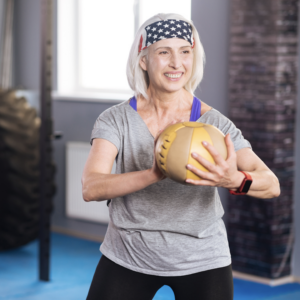Power Play: Add Power Training To Your Strength Training Exercise Routine

Power Play: Add Power Training To Your Strength Training Exercise Routine
March 20, 2024
Exercise is essential for healthy aging, and as we’ve repeatedly advised, that includes both aerobic exercise as well as strength training. Regular aerobic physical movement is critical to keeping your heart and brain functioning. Using your muscles and building up your strength is also essential if you want to continue as an independent, functional, injury-free older adult. Each time you challenge your muscles, using free weights, resistance bands, or your own body weight, you cause tiny tears in the muscles which, when they knit back together, result in stronger and more resilient muscles. We also know that strength training has additional benefits, ranging from increasing your bone density to improving your stability to uplifting your mental health. We even have data that now suggests that women who do strength training also appear to live longer than those who don’t. In an earlier post, we mentioned a recent study from the American College of Cardiology which reported that women only need to work out half as much as men to achieve a longevity boost. That same study also reported that women who strength train get a longevity boost and lower their risk of death in comparison to women who don’t strength train.
However, when it comes to exercise, strength training, while essential, may not be sufficient. It turns out that in addition to building and maintaining your strength, focusing on your power is also valuable. For example, while it’s important to have the leg strength to cross a street, it’s just as important to have the power and speed to cross that street before the light changes. Essentially, power reflects the combination of strength and speed, so that you can not only lift your luggage, but you have sufficient force to swing it into the overhead compartment. Power is also essential for such sports as golf or tennis- or even chasing after a grandchild. A recent article in The New York Times makes clear that power is the ability to apply force and strength rapidly so that you can not only lower yourself into a chair but can power yourself to get back up. Having power also allows you to quickly right yourself if you stumble to prevent falling, and gives you the endurance to go up several flights of stairs. Want to find out if you currently have sufficient “power?” The New York Times article suggests you try the 30 Second Chair Stand Assessment which requires you to sit and stand as many times as you can in 30 seconds, with your arms crossed over your chest and unavailable to help you. If that sounds exhausting or even impossible, then you’ve got your power training work cut out for you.
In a separate article, The New York Times gives you exercises for a “power workout” that in many ways resembles a strength training routine, using dumbells and slam balls to push yourself forcefully and quickly to improve your power along with your strength. Harvard Health Publishing also has a useful workbook with combined strength and power exercises to work your muscles, improve your force, and support your ability to move confidently as an older adult. Finally, one additional resource that may be new to you: Vivo is an online strength-training exercise program for adults 55 and over that creates small Zoom classes with personalized live trainers to help you safely and successfully work out. You can even create your own Vivo class with a group of friends. While it’s still in its early stage of development (you can read more about the company here) it might be just the solution to strengthening your muscles and power through your activities while enjoying a small live group experience with some familiar faces. Find out more about Vivo membership here.







